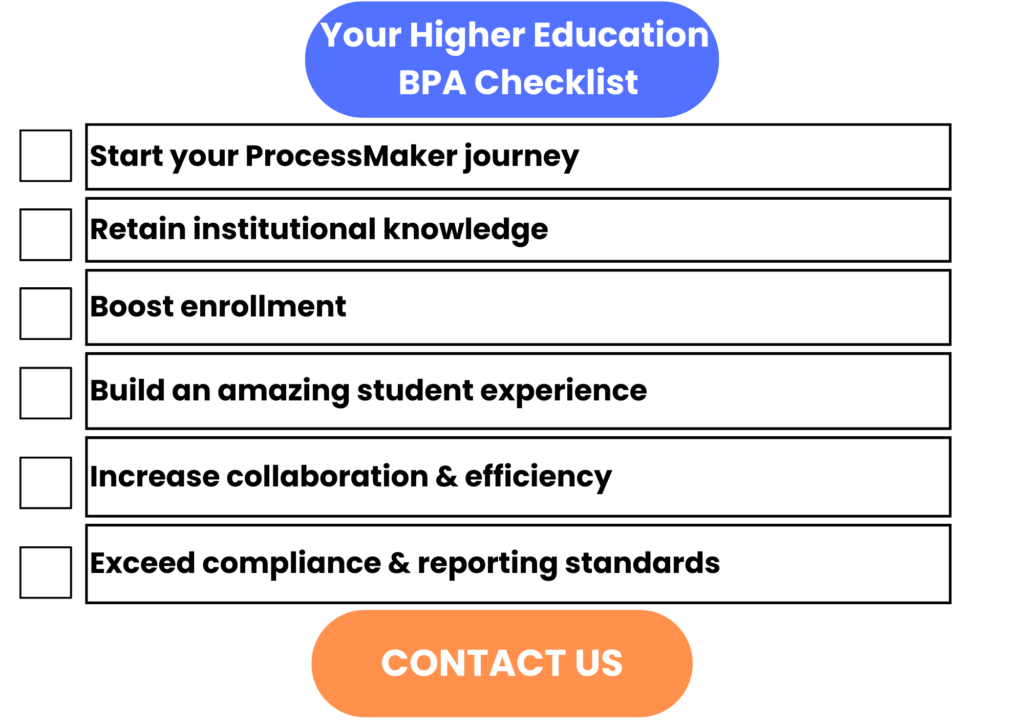When we hear about automation and AI in education news, it’s typically about ChatGPT’s impact on the college essay. But in higher education, automated technologies are also making waves in the back office. Higher ed leaders are increasingly turning to business process automation to boost application processing, improve the student experience, and reduce administrative red tape.
What is business process automation? It’s the use of technology to automate all the manual and repetitive tasks that drain efficiency and delay processing times. Tasks become more than a great paperwork shuffle—they move through a workflow like an item on a conveyor belt.
Software performs some tasks, like populating databases or filing forms. Humans make decisions and approve requests. An automation strategy can transform a weeks-long process into one that completes in mere days.
How? Higher education is one of the most paper-intensive industries, making it a prime use case for automation. From student records and applications to equipment requests and administration forms—the sector is awash in paperwork.
So colleges and universities are swiftly making the shift to digital. Over 50% of higher ed institutions report that over the next five years, they’ll use even more automation to reach their digital transformation goals. They’re automating tasks and activities in the Registrar’s Office, Financial Aid, The Office of Admissions, and more.
For a database coordinator at Tulsa Community College, an automation platform like ProcessMaker sped up sign-offs. “With automation, the process is instant. Notifications go straight to people’s phones. From an efficiency standpoint, ProcessMaker has greatly reduced our workload, and decreased the time it took for approvals and feedback for documents.”
Colleges and universities use business process automation to:
- Build a stellar student experience
- Increase campus-wide efficiency
- Retain institutional knowledge
- Boost enrollment
- Improve admissions timelines
- Reduce reporting errors
- Reduce data entry costs
- Allocate resources
- Exceed compliance and reporting standards
Let’s dive into the top five reasons why higher education leaders should leverage business process automation.
Retain institutional knowledge
At many colleges and universities, institutional know-how is locked inside the minds of a handful of staffers. While those individuals ace their powerhouse role, it’s challenging for newcomers to pick up the slack once they depart.
Unfilled job positions are a challenge for all colleges and universities. In one survey, 80% of higher ed leaders reported an uptick in empty roles, slowly draining institutional knowledge.
The issue is less of a threat for institutions that use business process automation. Individual employees no longer dictate how a process works. The system tracks and manages each task. If someone jumps ship for another role—no problem, there’s a detailed rulebook in place that keeps things running smoothly.
Boost enrollment by luring stopouts
Stopouts—or students who abandoned their education journey prior to graduation—total 36 million in the U.S. alone. This potential pool of students is massive for institutions that know how to tap into it.
Process automation is a key ingredient to any successful college re-enrollment campaign. While it sounds straightforward to faculty, it’s a daunting process for students. To find out how to best connect with these potential applicants, one team A/B tested outreach.
Two groups of students were targeted with different marketing campaigns. The first group was sent a generic email with information about the re-enrollment process. The second group received a personalized email that included a step-by-step plan for completing their degree.
Of the first group, only 4% opted to re-enroll. But something surprising happened with the second group. Over 10% of the pool that received the personalized blueprint signed back on to finish their degree.
The personalized campaign helped students to feel like they had a clear path forward, and it made them more likely to take action. Business process automation can power a similar plan for your institution by:
- Use business rules to compare a student’s academic progress to the degree requirements. Automation can summarize the findings in an email.
- Use dynamic forms to help students see what aid programs are available. They can quickly apply through a self-service portal.
- Instantly route follow-up questions to the right personnel.
With a unified view of all your data, you can use automation to engage with students in more valuable ways.
Click here to learn how ProcessMaker can benefit Higher Education.
Build a stellar student experience
One study shows that 76% of today’s applicants expect a response in four weeks. The same survey found that many students expect answers within one week—a startling stat for institutions relying on months-long admissions cycles!
The age-old admissions timeframe is rapidly changing to address these shifts in consumer preferences. Business process automation to the rescue: Ernst & Young finds that admissions offices can process a 250% increase in application volume using automation.
Increase campus-wide collaboration and efficiency
By bringing all of your tasks together into a single business process management platform, you can start coordinating activities in new and valuable ways. Surprised by the statistic that two-thirds of students in need never apply for help, institutions are using the newfound efficiency to build better awareness of student aid programs.
Why are students overlooking potential aid? They simply aren’t aware of the benefits offered by their school.
For institutions sticking to the manual route, the lack of coordination is what makes aid challenging to coordinate and fulfill. A representative from one department might only know about their offering, with no way to check on programs served by other departments.
So tech-forward institutions use process automation to build collaboration between all of their available aid programs. This includes housing, financial aid, and student services. Automation brings it all together—staff members can check a student’s eligibility for programs campus-wide. BPA can route approvals to the right personnel, and track the request from submission to completion.
Exceed compliance and reporting standards
Education also tops the list of industries subject to scrutiny and government oversight. Higher ed is leveraging automation to support compliance initiatives:
- Tracking student enrollment: Universities can ensure that they are meeting all applicable enrollment requirements, like those related to underrepresented groups and federal financial aid.
- Managing research data: Institutions collect information in a way that complies with regulations related to research ethics and data security.
- Generating reports on compliance status: Higher ed leaders can monitor progress toward meeting regulatory requirements—and identify areas where they need to improve.
With automation, you won’t need to manually file paperwork or track information like aid fulfillment. Software eases the administrative burden by handling the recordkeeping and archival.
Digital transformation through BPA can help higher education institutions streamline their operations, reduce costs, and enhance the student experience. By embracing BPA, higher education institutions can allocate their resources more effectively and focus more on their core mission of teaching and learning.
Make your organization’s workflow easier with ProcessMaker. Contact us to get in touch with one of our Business Process Automation experts.






